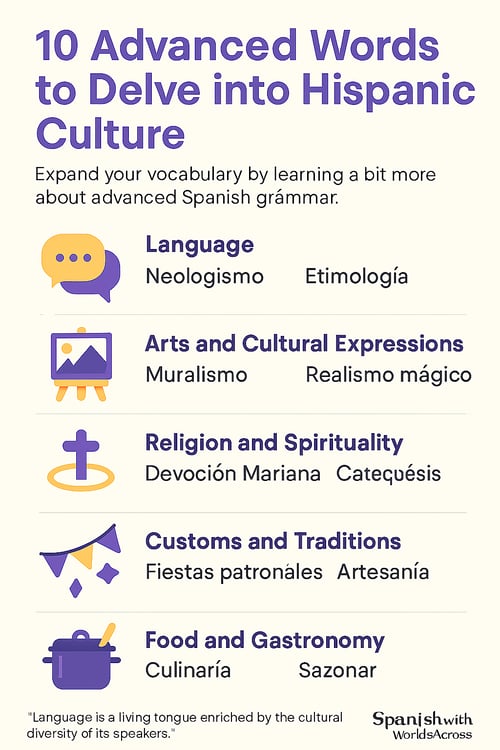10 advanced words to delve into Hispanic culture

Are you interested in learning about Hispanic culture?
There is a whole universe of stories, worldviews, social and religious structures, art, music, and incredible indigenous cultural richness that has also been enriched by international influences.
Indeed, Hispanic America is a cultural melting pot. Yes, this is one of the difficult words in Spanish that you might encounter when talking about culture. When we use this term in this context, we refer to how the diversity of societies with different beliefs, traditions, and origins unify in a space that becomes multiethnic and multicultural.
However, the word "crisol" is also defined by the Real Academia Española as "a vessel made of refractory material used to melt a substance at very high temperatures." As you can see, the richness of the language is also part of the Hispanic culture. Although there are difficult words in Spanish, learning the Spanish language is not an impossible task. We make it easier for you. Keep reading and discover some words you might hear, read, or use if you are interested in Hispanic culture.
We will start this journey by defining what culture is. We can understand it as an invisible fabric that intertwines traditions, languages, beliefs, customs, values, behaviors, art, music, and many forms of expression of a certain population, in this case, the Hispanic one. These threads go back centuries, loaded with richness.
Surely, if you have wanted to learn more about Hispanic culture, you have been interested in some of these aspects: language, arts, religion, customs, and gastronomy.
Therefore, here we will share with you 10 difficult words in Spanish that are used in each of these items. Expand your vocabulary by learning a bit more about advanced Spanish grammar.
Language
Our starting point on this journey through Hispanic culture. Language is an entire communication system composed of signs, symbols, gestures, and sounds that allow a population to express emotions, thoughts, and ideas.
When learning the Spanish language, you will come across two terms:
- Neologismo: A word or term recently created to designate an action, name an object, or refer to a concept. These belong to a specific population, space, and time.
Example: “The term ‘tuitear’ is a neologism that emerged with the popularization of social networks.”
On the other hand, when it comes to difficult words in Spanish, understanding where they come from can make them easier to grasp. For this, you should know the etymology of the words.
- Etimología: This refers to the study of the origin and historical evolution of words and the changes they have undergone in meaning and form.
Example: “The etymology of the word ‘etymology’ comes from ancient Greek —etymon— meaning ‘true meaning’ and —logos— meaning ‘study or science’.”
Arts and Cultural Expressions
When we talk about culture, we know that one of its greatest forms of expression is art. This includes music, literature, theater, painting, architecture, dance, sculpture, etc. Did you know that one of the forms of Latin American artistic representation that became well-known in North America was Muralism?
- Muralismo: A Mexican artistic movement that became popular both nationally and internationally in the first half of the 20th century. It involved creating large murals in public spaces. These depicted social, political, and cultural scenes, also making critiques or showcasing beauty.
Example: “Mexican muralism, led by artists like Diego Rivera, José Clemente Orozco, and David Alfaro Siqueiros, is recognized for its monumental works reflecting Mexico’s history and culture.”
But culture is not only expressed in pictorial art, but also in literature; you might have heard the term —Realismo mágico—.
- Realismo mágico: A literary style that combines fantastic or magical elements with realistic ones, allowing the ordinary to coexist with the extraordinary. It became popular in Latin America in the 20th century. Example: “One Hundred Years of Solitude by Gabriel García Márquez is an iconic example of magical realism where the fantastic and the real intertwine in the narrative”.
Religion and Spirituality
Hispanic culture has much syncretism, ceremonial practices, and expressions of faith that combine indigenous beliefs with religion brought from other nations. Especially, Latin Americans are quite devoted to Catholic or Christian religions. Surely, if you explore this culture, you will hear about —Devoción Mariana—.
- Devoción Mariana: This refers to the veneration and worship dedicated to the Virgin Mary, mother of Jesus Christ.
Example: “In many Spanish-speaking countries, Marian devotion is manifested through religious celebrations such as the festivities of Our Lady of Guadalupe in Mexico or Our Lady of Carmen in Spain.”
You might also encounter another key word of advanced Spanish grammar in religious context:
- Catequesis: The religious teaching intended to prepare individuals to receive the sacraments and deepen their understanding of the Christian faith, usually beginning from childhood with the first confession, first communion, solemn communion, and confirmation.
Example: “During catechesis, catechists use various didactic resources to convey the values and teachings of the gospel”.
Customs and Traditions
Culture is not culture without customs and traditions, forms of behavior, and practices passed down from generation to generation, including rituals, celebrations, festivities, ceremonies, taboos, and norms. Something you surely wouldn’t want to miss is the —fiestas patronales—.
- Fiestas patronales: In them, you can also learn songs that would help you learn the Spanish language. Due to the great religious devotion many Spanish-speaking populations have, these religious and cultural celebrations in honor of a town’s patron saint are often quite elaborate, including processions, dances, masses, fairs…
Example: “In many cities and towns in Latin America and Spain, the patronal festivals are the highlight of the year, attracting visitors and pilgrims from all over.”
On the other hand, if you visit a Spanish-speaking region, we are sure you wouldn’t want to leave without taking a personal souvenir from the place, and what better than a handicraft.
- Artesanía: Manual creation that involves the production of unique objects using traditional techniques and native materials to reflect cultural identity.
Example: “In many indigenous communities, handicrafts are an important source of income and preserve ancestral techniques of weaving, ceramics, and carving”.
Food and Gastronomy
Another territory, other flavors. Hispanic culture is full of particular colors and flavors, enriched by the vast variety of fruits, vegetables, legumes, and proteins these territories have. This makes many regions known for their culinary arts.
- Culinaria: The set of knowledge, techniques, and practices related to food preparation.
Example: “Peruvian cuisine is internationally recognized for its diversity of flavors and its rich gastronomic heritage.”
One thing these dishes surely don’t lack is seasoning.
- Sazonar: The act of adding spices, condiments, and aromatic herbs to food during its preparation to enhance its flavor.
Example: “Mexican cuisine is characterized by the use of chiles and aromatic herbs to season its dishes, creating vibrant flavor combinations.”

By learning and using difficult words in Spanish, we not only expand our linguistic abilities but also gain a deeper understanding of the cultural and social concepts these words represent. If you are interested in the language, advanced Spanish grammar, and culture, just like us, you will surely be encouraged to keep learning.
And remember: “Language is a living tongue enriched by the cultural diversity of its speakers.” Real Academia Española.





